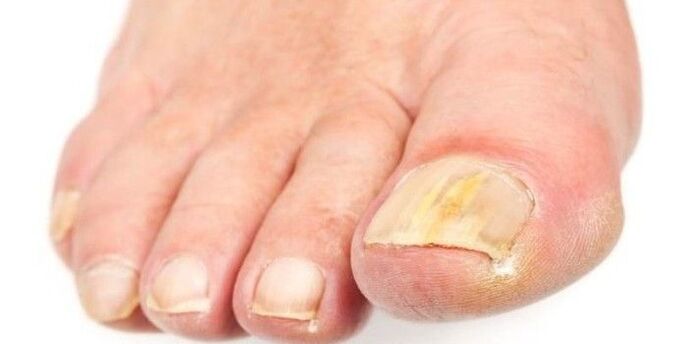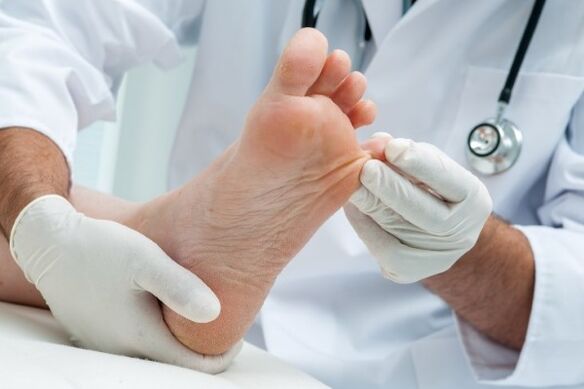This fungus, also known as Onychomycisosis, is an infection on the surface of the nail caused by skin plants, yeast or mold.
The color of the nails changed, it first got a white hue, then darker and smelled very nice. Drama, deformation, begins to collapse.
The infection is likely to spread to other nails on the legs and to adjacent skin. I feel sore when walking and wear shoes. Therefore, fungi must be processed on time.
Causes of nail fungi

The causes of oncology are dull:
- Contact with ubiquitous microscopic mushrooms. Another problem is that nails are prone to infection when a person walks barefoot in a wet place - the pool, locker room and shower are great for picking up fungi.
- Infections of damaged nails, cracks, damaged fingers, other bacteria or pus can penetrate the skin plants slightly into the body.
- A person with chronic diseases such as diabetes, peripheral vascular disease and immunodeficiency disease is a Class A candidate for fungal infections in the legs.
If there is irritation, the rate of leg sweating is high, and shoes will be limited to prolonged ventilation barriers - an ideal environment for controversial growth.
Symptoms of nail fungus
The most common symptom caused by fungal infection is thickening of the plate. Nails can be floated, white, black, yellow or green.
As the disease progresses, it becomes fragile, and the small nails break or can be completely separated from the fingers. If you don't have the attention you deserve, the skin under it will swell and become painful, scaly. An unpleasant smell occurs
If the disease does not function, there are usually no other symptoms. Sometimes, the body can respond without any damage to the fungus in the skin. Rash or itching caused by skin plants can be an allergic reaction to fungi.
Risk factors for nail fungus development
Anyone can get infected on the fingers of the legs, but certain risk factors make it easier for people to get infected with fungal nails. Some of them are as follows:
- Performance is the main risk factor for the occurrence of nail fungi. As people age, the quality of blood vessels decreases and the blood supply to the surrounding areas is disturbed, which is why nail growth and general susceptibility to infection slows down.
- Men's floors tend to have nail fungus.
- Sweat increases, and a person works in a humid environment, such as erasing, washing, cleaning or cooking food.
- Wearing socks and shoes can prevent ventilation of the leg skin, and the synthetic materials will not absorb sweat, so choose cotton products.
- If you live with someone with nail fungus, you can get infected.
- Walk barefoot in pristine places such as swimming pools, gyms and showers.
- Irritation between fingers, itching, peeling, skin or nail damage, psoriasis.
- Chronic diseases such as diabetes, peripheral vascular diseases, weak immunity and certain syndromes such as Down syndrome.
Complications of fungi
A severe infection on the legs can be very painful and cause continuous damage to the nails. If a person has depression, immune system, diabetes, or any other chronic disease, the risk of complications is high. Using diabetes, blood circulation is reduced and neuropathy is often occur. Sometimes you can’t sense the pain.
Therefore, not only the fungus of the nails, but any minor damage to the legs can be a serious problem. If a person has diabetes and he feels infected, that is reasonable.
Testing and diagnosis
Infections of nail fungi are sometimes misdiagnosed as psoriasis, contact dermatitis, and tumors such as melanoma. To avoid incorrect diagnosis, laboratory tests may be required.
Generally, there are three methods:
- The first is a smear cooked with potassium hydroxide.
- Secondly, it is a culture of infectious organisms.
- The third is histological confirmation of the body.
These three methods use microscopic studies of nails obtained by spatula or trimming.
Based on some recent improvements, from a sensitivity point of view, the most useful is direct strokes, using a periodic acid spoon of glaciers to perform histological examination and biopsy of the nail plate.
Several samples may be required to correctly diagnose fungal organisms.
prevention

The first step can be taken to prevent fungal infections in the legs to observe proper hygiene. Pure legs will definitely prevent any fungal infection.
Rinse them thoroughly regularly with soap and don't forget to dry them after surgery. In public places, you need to wear shower slippers.
You may not change your shoes, socks and underwear once a day.
Improve nail cutting techniques – Cut them so that your nails don’t go beyond your feet.
Maybe you have to wear shoes that don't fit your fingers, and their materials should provide ventilation.
Avoid wearing cotton or wool socks. Love socks made from special synthetic fibers that absorb moisture from the legs more efficiently than cotton and wool.
Drink nails and pedicure tools. Do not use varnish on infected nails.
When to see a doctor
If a fungal infection of the nail causes signs of bacteria, it is worth making an appointment with your doctor: You should check for a list of signs and symptoms for the exact diagnosis and correct choice of the medication.
Doctors will examine the patient, listen to the complaint, and then perform primary tests by collecting biological materials to determine the type of fungus. The results and treatment purposes were then fully analyzed.
Treatment and affordable medicines
If the fungal infection is mild, complex treatments are not required. However, ignoring it can cause it to spread to other nails. Here are the treatment options available for nail fungi:
Drugs are usually recommended when fungal nail infection is severe.
You may need to take the medication for several months so that the infection has gone away. The cessation of the drug will lead to premature recurrence. Some side effects of the medication may include headache, itching, loss of taste, nausea, and diarrhea.
If a person does not want to take pills, the doctor will recommend using nail polish. It is not as effective as an oral product, as it cannot always go deep into the nails and into the focus of the infected area. Terms of use are up to 12 months.
Chemical denaturation of nails
A paste containing 40% urea can be used to chemically remove the appearance of nails. Pasta is easy to obtain in pharmacies. You need to secure it to your nails, cover it and leave it overnight. Rinse pasta in the morning and repeat the process every day. The infected plate will dissolve in about 2 weeks.
This is a painless treatment option that can remove patients with nails and gradually eliminate mycotic diseases. With this treatment, pills are not required for months and surgery can be avoided.
Surgery and laser therapy
If it is very painful, it is recommended to perform surgery to remove infected nails only under difficult conditions, and other treatments will not help. After the surgery, the nails will start to grow again, but it may take a year to fully recover.
Is laser therapy a good choice to get rid of nail fungi?
In the case of stubborn nail infection, laser treatment is possible. The laser emits a high dose of light energy, which kills and destroys mushrooms.
According to the study, laser treatment is completely safe, with a treatment rate of 90% after three months. However, this requires repeated every three months of the year and is not cheap.
How long can you treat nail fungi?
Treatment of nail infections can be a long and expensive process.
The surrounding medication works on average about four months, while infected nails are replaced by health.
When using antifungal nail polish, the duration of treatment increases and may take a year.
Laser and surgical resections provide faster results.
















